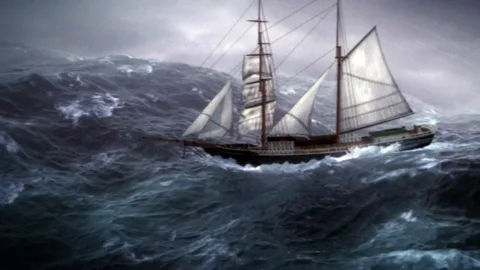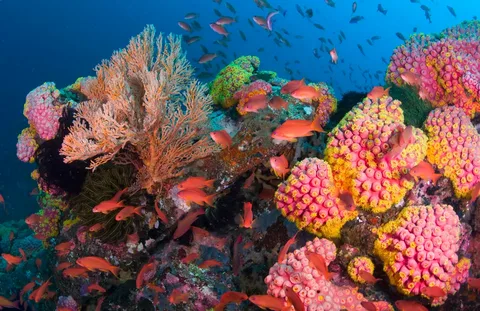Adverts
In the vast and mysterious world of the oceans, there is a place where the pressure is so intense that few living things can survive. The deep sea is an extreme environment, where the darkness is total and the pressure is crushing. But to our surprise, there are animals that not only survive, but thrive in these harsh conditions. In this article, we will explore the fascinating world of deep-sea survivors and how they manage to withstand extreme pressure.
We’ll discover how these marine animals, such as deep-sea fish, molluscs and crustaceans, have adapted to the harsh environment of the deep. The pressure at great depths is so intense that it could crush a human being in a matter of seconds, but these animals have developed ingenious strategies to deal with this challenge. We’ll explore their physical adaptations, such as flexible bodies, cartilaginous skeletons and special membranes that protect them against extreme pressure.
Adverts
We will also see how these animals obtain food and reproduce in this dark and hostile environment. How do they manage to find prey in a place where sunlight never penetrates? How do they reproduce and ensure the survival of their species? These are some of the questions we will answer.
Get ready for a fascinating journey into the mysteries of the deep ocean and discover how marine animals have adapted to extreme pressure. So, dive with us on this exploration and uncover the secrets of the deep-sea survivors. Be prepared to be amazed by the incredible diversity and resilience of these creatures. Let’s start this incredible journey right now!
Adverts
Survivors of the Deep: How Marine Animals Withstand Extreme Pressure
Imagine being in an environment where the pressure is so intense that it could crush a human being in a matter of seconds. This is the challenge faced by marine animals that live in the depths of the ocean, where conditions are extremely hostile. However, these animals have surprised scientists with their survival skills, adapting in impressive ways to withstand the extreme pressure.
The benefits of this topic are fascinating and go beyond simply satisfying curiosity. By understanding how marine animals cope with extreme pressure, we can gain valuable insights into engineering, medicine, and even space exploration. These deep-sea survivors are true masters of adaptation, and their knowledge could help us develop advanced technologies and improve our understanding of life in other extreme environments.
An impressive example of adaptation is the case of deep-sea fish, which are able to withstand extreme pressure due to their unique body structure. They have flexible bodies, without a swim bladder, which prevents them from being crushed by the pressure. In addition, these fish have highly compressible internal organs and elastic membranes, which allow them to adjust to changes in pressure quickly. These adaptations make them true masters of survival in the deep ocean.
Another interesting example is cephalopods, such as octopuses and squids, which have a unique body structure that allows them to withstand extreme pressure. They have a gas-filled chamber called a “swim chamber” that regulates their buoyancy and helps them resist pressure. In addition, they have thick, tough skin and a powerful muscular structure that protects them against the harsh environment of the deep.
These adaptations are not only fascinating, but they also have practical implications. For example, engineering can take inspiration from the body structures of marine animals to develop stronger, more durable materials. Medicine can also benefit from these adaptations, studying how marine animals deal with extreme pressure to develop treatments for pressure-related diseases such as saturation diving.
Furthermore, space exploration can benefit from studying these deep-sea survivors. Like marine animals, astronauts face extreme conditions, such as weightlessness and intense pressure. Understanding how marine animals cope with extreme pressure can help us improve the safety and performance of astronauts during long-duration space missions.
In short, marine animals that survive in the depths of the ocean are true survivors of extreme pressure. Their impressive adaptations can provide us with valuable insights into everything from engineering to medicine to space exploration. By studying these animals, we can unlock the secrets of survival in extreme environments and draw inspiration from their adaptive strategies to face future challenges.
Conclusion
In conclusion, the study of deep-sea survivors reveals a fascinating adaptation of marine animals to the extreme pressure of the ocean depths. These creatures, such as deep-sea fish, cephalopods and crustaceans, have developed a series of physical and behavioral characteristics that allow them to survive in a challenging environment.
One of the main strategies adopted by marine animals to withstand extreme pressure is to modify their body structure. For example, they have flexible bodies and poorly developed spines, which allow them to resist compression caused by water pressure. In addition, their cells are able to resist pressure through adaptations in cell membranes and structural proteins.
Another important strategy is to reduce metabolism and energy consumption. The low availability of food in the deep ocean requires these animals to be highly energy efficient. They have lower metabolic rates compared to animals in shallower waters, which allows them to survive on minimal amounts of food.
In addition, these animals have highly developed sensory organs, such as large, light-sensitive eyes and lateral line organs, which allow them to detect movement and changes in water pressure. This is essential for their survival, since the deep ocean is a dark and silent environment.
In short, deep-sea survivors are true examples of evolutionary adaptation. Their ability to withstand the extreme pressure of the deep ocean through physical, behavioral, and metabolic modifications is astonishing. Studying these animals not only provides us with valuable insights into life in the deep ocean, but also helps us better understand the adaptive mechanisms that allow survival in extreme environments.




